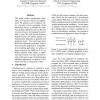Free Online Productivity Tools
i2Speak
i2Symbol
i2OCR
iTex2Img
iWeb2Print
iWeb2Shot
i2Type
iPdf2Split
iPdf2Merge
i2Bopomofo
i2Arabic
i2Style
i2Image
i2PDF
iLatex2Rtf
Sci2ools
ACL
2009
2009
Transliteration Alignment
This paper studies transliteration alignment, its evaluation metrics and applications. We propose a new evaluation metric, alignment entropy, grounded on the information theory, to evaluate the alignment quality without the need for the gold standard reference and compare the metric with F-score. We study the use of phonological features and affinity statistics for transliteration alignment at phoneme and grapheme levels. The experiments show that better alignment consistently leads to more accurate transliteration. In transliteration modeling application, we achieve a mean reciprocal rate (MRR) of 0.773 on Xinhua personal name corpus, a significant improvement over other reported results on the same corpus. In transliteration validation application, we achieve 4.48% equal error rate on a large LDC corpus.
ACL 2009 | Alignment Entropy | Computational Linguistics | Transliteration Alignment | Transliteration Validation Application |
| Added | 16 Feb 2011 |
| Updated | 16 Feb 2011 |
| Type | Journal |
| Year | 2009 |
| Where | ACL |
| Authors | Vladimir Pervouchine, Haizhou Li, Bo Lin |
Comments (0)

